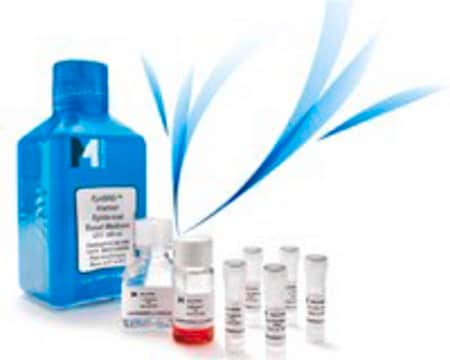MABF2789
Anti-SARS-CoV-2 nucleocapsid Antibody, clone 5B9-C6
About This Item
Productos recomendados
biological source
mouse
Quality Level
conjugate
unconjugated
antibody form
purified antibody
antibody product type
primary antibodies
clone
5B9-C6, monoclonal
mol wt
calculated mol wt 45.63 kDa
observed mol wt ~53 kDa
species reactivity
virus
packaging
antibody small pack of 100 μL
technique(s)
ELISA: suitable
immunofluorescence: suitable
immunoprecipitation (IP): suitable
western blot: suitable
isotype
IgG1κ
UniProt accession no.
shipped in
dry ice
storage temp.
2-8°C
target post-translational modification
unmodified
Gene Information
SARS coronavirus ... N(43740575)
General description
Specificity
Immunogen
Application
Evaluated by Western Blotting in lysates from HEK293T cells expressing SARS-CoV-2 Nucleocapsid protein.
Western Blotting Analysis (WB): A 1:1,000 dilution of this antibody detected Nucleocapsid protein in lysates from HEK293T cells expressing SARS-CoV-2 Nucleocapsid protein, but not in lysates from the wild type HEK293 T cells.
Tested Applications
Immunoprecipitation Analysis: A representative lot Immunoprecipitated SARS-CoV-2 nucleocapsid protein. (Courtesy of Stefan Schüchner, Ingrid Mudrak, Ingrid Frohner, and Egon Ogris (Max Perutz Labs, Medical University of Vienna, Austria).
ELISA Analysis: A 1:3 dilution from a representative lot detected SARS-CoV-2 nucleocapsid protein. (Courtesy of Stefan Schüchner, Ingrid Mudrak, Ingrid Frohner, and Egon Ogris (Max Perutz Labs, Medical University of Vienna, Austria).
Western Blotting Analysis: A 1:1,000 dilution from a represenative lot detected SARS-CoV-2 nucleocapsid in Whole cell lysates of HEK293T cells expressing the nucleocapsid (NC) proteins of various human coronaviruses (Courtesy of Stefan Schüchner, Ingrid Mudrak, Ingrid Frohner, and Egon Ogris (Max Perutz Labs, Medical University of Vienna, Austria).
Immunofluorescence Analysis: A 1:100 dilution from a represenative lot detected SARS-CoV-2 nucleocapsid in HeLa cells transiently transfected with SARS-CoV-2 NC-P2A-GFP (Courtesy of Stefan Schüchner, Ingrid Mudrak, Ingrid Frohner, and Egon Ogris (Max Perutz Labs, Medical University of Vienna, Austria).
Note: Actual optimal working dilutions must be determined by end user as specimens, and experimental conditions may vary with the end user
Physical form
Storage and Stability
Other Notes
Disclaimer
Not finding the right product?
Try our Herramienta de selección de productos.
Optional
Storage Class
12 - Non Combustible Liquids
wgk_germany
WGK 1
flash_point_f
Not applicable
flash_point_c
Not applicable
Certificados de análisis (COA)
Busque Certificados de análisis (COA) introduciendo el número de lote del producto. Los números de lote se encuentran en la etiqueta del producto después de las palabras «Lot» o «Batch»
¿Ya tiene este producto?
Encuentre la documentación para los productos que ha comprado recientemente en la Biblioteca de documentos.
Nuestro equipo de científicos tiene experiencia en todas las áreas de investigación: Ciencias de la vida, Ciencia de los materiales, Síntesis química, Cromatografía, Analítica y muchas otras.
Póngase en contacto con el Servicio técnico







